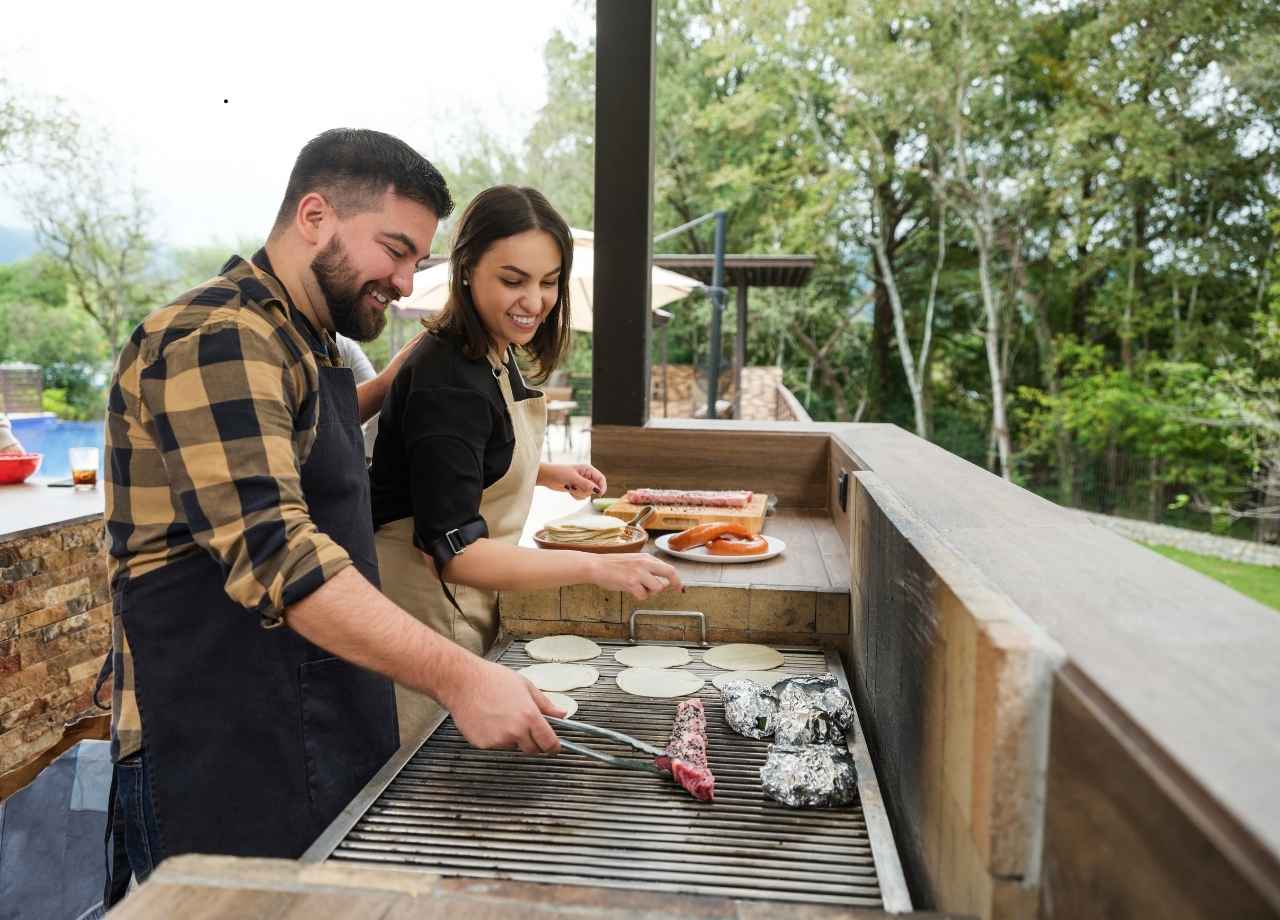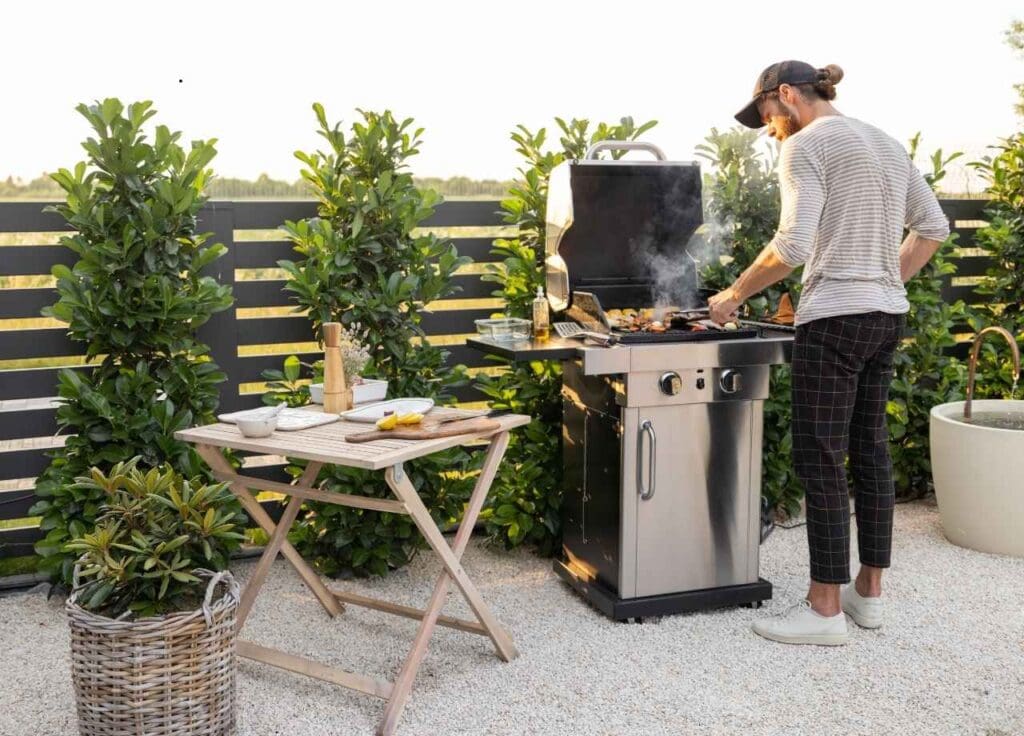
Built-In Grills for Outdoor Kitchens: What to Look For
Choosing the right built-in grill is one of the most important decisions you’ll make when designing an outdoor kitchen. It’s the heart of the setup—the centerpiece that defines the cooking experience and often shapes the layout around it. A grill that looks the part but underperforms or doesn’t hold up to weather exposure in Florida isn’t just a minor inconvenience—it’s a costly oversight. At Calico Outdoor, we help clients across Jacksonville choose the right components for their space, making sure every outdoor kitchen is as functional as it is beautiful.
Table of Contents
Start with the Fuel Type
Before diving into features, sizes, or aesthetics, figure out your fuel preference. Built-in grills typically fall into three categories: natural gas, propane, or charcoal. Each has its own pros and limitations. Natural gas grills are convenient for homes already set up with a gas line and offer uninterrupted cooking without having to swap tanks. Propane grills are more flexible with placement and easy to replace, but you’ll have to monitor your fuel levels. Charcoal grills give that classic smoky flavor, but they require more cleanup and hands-on temperature control. For most homeowners looking for a seamless experience in a modern outdoor kitchen, gas grills—natural or propane—tend to be the go-to.
Build Quality Matters More Than You Think
Outdoor kitchens don’t get the climate-controlled luxury of an indoor setup. The grill you choose needs to stand up to Florida’s salty air, heat, humidity, and afternoon downpours. Stainless steel is the standard for a reason, but not all stainless is the same. Look for 304-grade stainless steel—it’s durable, corrosion-resistant, and holds up well to harsh conditions. Thinner, lower-grade stainless might look shiny out of the box, but it won’t last.
Seamless welds, solid construction, and heavy-duty hardware are all details that signal long-term durability. Hinges, grates, and knobs should feel solid and responsive. If it feels flimsy in a showroom, it won’t feel any better after a year of use.
Pay Attention to Heat Output and Distribution
High BTU numbers sound great on paper, but raw power doesn’t automatically mean better performance. What you want is efficient, even heat distribution. Hot spots and cold zones will make it frustrating to cook for a crowd or to time a meal with multiple components. Quality built-in grills use well-designed burner layouts, flame tamers, and cooking grids to deliver consistent heat from edge to edge.
Also, consider how many burners the grill offers. More burners give you better control over zones and allow for more flexible cooking styles. You can sear a steak on one side while roasting vegetables on the other. For frequent entertainers or families who cook multiple meals outdoors each week, this is a game changer.
Grill Size Should Match the Way You Cook
Grill size is more than just a number. A 36-inch grill can feel either oversized or just right depending on how you use it. Are you usually cooking for two, or hosting weekend gatherings with ten or more guests? It’s not just about surface area either—pay attention to usable space. Warming racks, secondary cooking levels, and side burners can dramatically increase your options.

At the same time, a larger grill in a small outdoor kitchen can throw off the balance of the layout. If you’re working with a compact patio or built-in setup, the grill should integrate well with surrounding counter space, appliances, and storage.
Think Beyond the Grill Surface
Built-in grills today can do far more than just sear burgers. Many models come with advanced features that expand your outdoor cooking capabilities. Rotisserie systems, integrated smokers, infrared sear burners, and interior lighting aren’t just extras—they can make a real difference in how and what you cook. Whether it’s a slow-roasted chicken or late-night grilling, these add-ons boost functionality.
While these features are appealing, it’s important to choose a grill that fits your cooking habits rather than simply checking boxes. Someone who rarely grills at night might not need integrated lights, but if you’re an evening host, they’re worth having.
Ease of Cleaning and Maintenance
Grilling should be enjoyable—cleaning up afterward, not so much. A good built-in grill should be easy to clean and maintain. Look for removable drip trays, easy-access grease management systems, and components that can be disassembled without needing a toolbox.
Additionally, grills that resist buildup of food particles or have non-stick cooking grates reduce your maintenance workload over time. The easier it is to keep clean, the more likely you’ll use it regularly.
Ventilation and Safety Are Non-Negotiable
Built-in grills generate a lot of heat, and when installed into cabinetry or under a hood, ventilation becomes critical. An improperly vented grill island can trap heat and lead to damage or worse. Be sure the setup includes proper vent panels and meets all manufacturer guidelines for clearances.
If your grill is going under a pergola, awning, or any covered area, a vent hood designed for outdoor use may be necessary. These not only improve air quality and safety but also help protect nearby surfaces from grease buildup and discoloration.
Warranty and Manufacturer Support
A solid warranty isn’t just about fixing what might break—it’s a vote of confidence from the manufacturer. A built-in grill is an investment, and you should feel supported by the brand behind it. Read the fine print. Some warranties cover the burners for longer than other parts. Some require registration or have restrictions on commercial or coastal installations.
Look for brands that have a proven track record and local support if possible. It’s easier to deal with an issue when you know help is nearby.
Built-In Doesn’t Mean Set-It-and-Forget-It
Once installed, a built-in grill becomes part of the architecture of your outdoor space. It’s not something you’ll easily swap out like a portable grill on wheels. Choosing the right one from the start helps avoid regrets and replacement costs. It’s also worth thinking about how your outdoor kitchen may grow. Planning for add-ons, extra burners, or compatible accessories down the road keeps you flexible.
Take your time when selecting a built-in grill. The upfront effort pays off in better meals, smoother gatherings, and fewer headaches later. Jacksonville’s climate makes outdoor living a year-round opportunity—you want a grill that keeps up with that lifestyle and enhances it.
If you’re in the process of building or upgrading an outdoor kitchen in Northeast Florida, Calico Outdoor can help you choose and install the right grill setup for your space. Every project we design puts performance, durability, and style at the forefront, so your investment works just as well five years from now as it does today.
